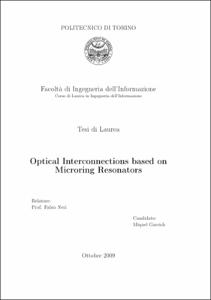Mostra el registre d'ítem simple
Optical Interconnections based on Microring Resonators
| dc.contributor | Neri, Fabio |
| dc.contributor.author | Garrich Alabarce, Miquel |
| dc.contributor.other | Universitat Politècnica de Catalunya. Departament d'Arquitectura de Computadors |
| dc.date.accessioned | 2009-12-14T07:54:42Z |
| dc.date.available | 2009-12-14T07:54:42Z |
| dc.date.issued | 2009-10 |
| dc.identifier.uri | http://hdl.handle.net/2099.1/8088 |
| dc.description | Projecte fet en col.laboració amb la Facoltà di Ingegneria dell’Informazione. Politecinco de Torino |
| dc.description.abstract | The aim of this thesis is to present and analyse optical interconnection architectures based on microring resonators. The trend of meeting large bandwidth and strict latency requirements in both global on-chip and off-chip communication face critical challenges in maintaining a sustainable performance-per-watt. Optical technologies support the immense bandwidth allowed by wavelength division multiplexed (WDM) while could offer a significant power saving switching capabilities. Microring resonators have received considerable attention as promising technologies for realizing photonic integrated circuits. Their small footprint and their capacity for processing high-bandwidth WDM data can lead these devices become the key elements for the switch nodes in next-generation telecommunication networks. This thesis firstly describes the basic principles of operation of a microring resonator defining 1x2 basic switching element (1B-SE). Then, the 2x2 basic SE (2B-SE) based on two 1B-SEs jointly controlled and the new 2x2 mirrored SE (2M-SE) are characterised as atomic building elements for interconnection architectures. The severe asymmetric behaviour presented by those SEs could limit the scalability of classical optical switching fabrics and we aim at balancing the complexity and optical signal level. In a second stage, the well-known switching theory is revised in order to classify the interconnection architectures according to their characteristics when using that SEs as building element. It is applied an exhaustive procedure to obtain the performance of classical Crossbar and Benes structures and of the newly proposed Mirroring and HBC structures. Thereafter, using as a starting point for each analysed structure the characterisation previously obtained, the scalability response of larger switching fabrics is explored. Then we define a construction rule for the new proposed architectures of which we assess the complexity in terms of used microrings |
| dc.language.iso | eng |
| dc.publisher | Universitat Politècnica de Catalunya |
| dc.rights | Attribution-NonCommercial-NoDerivs 3.0 Spain |
| dc.rights.uri | http://creativecommons.org/licenses/by-nc-nd/3.0/es/ |
| dc.subject | Àrees temàtiques de la UPC::Enginyeria electrònica::Optoelectrònica |
| dc.subject.lcsh | Dielectric resonators |
| dc.title | Optical Interconnections based on Microring Resonators |
| dc.type | Master thesis (pre-Bologna period) |
| dc.subject.lemac | Ressonadors dielèctrics |
| dc.rights.access | Open Access |
| dc.audience.educationlevel | Estudis de primer/segon cicle |
| dc.audience.mediator | Escola Tècnica Superior d'Enginyeria de Telecomunicació de Barcelona |
| dc.audience.degree | ENGINYERIA DE TELECOMUNICACIÓ (Pla 1992) |


